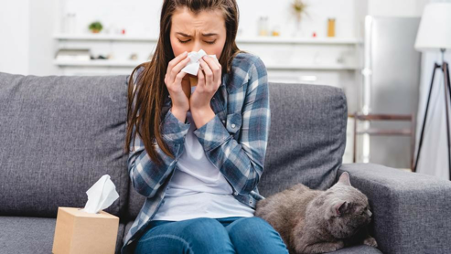Fur Allergies
Causes, Symptoms, Treatment, and Side Effects of Fur Allergies and Pet Allergies
Fur Allergies Overview
Ever went back home from a tired day of your office or school, and your furry pet runs up to you and starts playing with you, leaping and cuddling you, but all of a sudden, your chest tightens, and it is hard to breathe. This means that you have a fur allergy. Studies have shown that every three in ten people are suffering from fur allergies. It is more common in people who have asthma or chronic bronchitis, but it can occur to healthy people as well. Some surveys have also shown that the rate of cat allergies are more common than dog allergies.

What Causes Fur Allergies?
Causing difficulty in breathing and other symptoms. There are many allergens causing different allergies, but in the case of fur allergy, the aggravating factors are
- Dander
- Urine
- Saliva
Some people consider pet hair or fur as an allergen, but it is not true. Actually, the pet hairs can pick up these allergens, causing the allergy. Animal hairs naturally produce Dander on their skin, which can shed off to other furniture such as carpets, causing an allergic attack any time you walk over that carpet. These allergens are not only limited to pets. They are found in our environment at all times but in relatively low amounts, but it can pile up on your clothes and other fabrics such as curtains causing a surprise allergic attack.
Symptoms of Fur Allergies
Symptoms of fur allergies vary from person to person; it depends upon how quickly their immune system is responding to the allergen. Following are some signs of mild fur allergies:
- Runny Nose
- Red, Itchy, Watery Eyes
- Sneezing
- A slight rash on face or chest
- Itchy Throat
- Postnasal drip

This symptom should last about 30 minutes to an hour, and taking some anti-allergy drugs can help cure it even earlier. Still, if these symptoms last more than a day, then you are facing a severe fur allergy reaction, which can last for one to two weeks under medication. The symptoms can transform to:
- Difficulty breathing
- Audible whistling sound when exhaling
- Chest tightness
- Chess discomfort
- Trouble sleeping because of shortness of breath or wheezing
- Itchy skin
These symptoms indicate that you are having an asthma attack and needs an inhaler or nebulizer to open up your airways and regain proper airflow.
When to see a doctor: Having a runny nose and sneezes after playing with your pet is somewhat common and nothing to afraid about, it is the standard form of fur allergies. But If your symptoms are worsening, do not get stable under two to three hours, then rush o see a doctor and seek emergency help.
What Triggers Fur Allergies?
Fur allergies get triggered differently for every person, for some people, this allergy is triggered when their pet enters their room, or for some, it triggers when their furry pet licks them or when they pet their pets.
When a pet shakes its body, it releases the allergens in the air, and according to studies, it stays airborne for thirty minutes, and it stays in the house for three to six months even when the pet is not in the house, which means in between that time if you sniff those aggravating factors in your body, you surely going to get an allergy attack.
Prevention
Fur allergies can be prevented by taking notes on how your allergy is triggered and when. This is a crucial step s it even plays a role in your diagnosis with your doctor. To minimize the risk of severe symptoms, you can implement the following things in your life:
- Don’t let your pet enter your bedroom.
- Put its litter box outside the house.
- Give your pet a daily bath.
- Get your self a hypoallergenic breed of cat or dog.
- Put your furry in a cold environment, so it doesn’t produce too much Dander.
- Cover your air vents with extra filters. Cheesecloths works the best.
- Groom your furry and make sure that the hair length doesn’t get too long.
- Ask someone who doesn’t have a fur allergy to remove the dander from your pet by thorough brushing.

Treatment
Fur allergies are annoying and can prevent you from having group gatherings and even visits to friends and family members who have pets. But fear not, there are many treatments out there which have cured fur allergy for many people. If you have a mild allergy to furry pets, then taking a pill of an anti-allergy drug should work for you. But if you are suffering from a severe fur allergy, then the best treatment with the most scientific supporting data is immunotherapy.
It works by exposing the patient with the allergen and telling the body chemically that these products are not harmful. This method has worked for many people in the past, and with the consultation of your doctor and with the right plan, it should work for you as well.
Conclusion
Fur allergies can go out of control real quick, and some few wrong steps can end you up in a hospital bed. So to prevent all of this hassle, always take notes on how your allergy is changing and consult with your doctor if new symptoms have shown or some factors that used to trigger the allergy are not triggering it anymore. Always remember that allergy can get cured on its own, so don’t forget to consult your doctor if you see any change.
If you want a pet but don’t need allergy to try pets without furs such as lizards or snakes and even birds like owls. Fishes are the best option. There are many friendly animals in the world except for dogs and cats. Visit exotic pet stores to find something that suits you, such as a color changing chameleon. You can even talk to your allergist for viable choices.
Written by: Madiha Ather Hashmi (May 05, 2020)
Sources
- May Clinic Staff (2019). “Pet Allergy”. Mayo Foundation for Medical Education and Research (MFMER).
https://www.mayoclinic.org/diseases-conditions/pet-allergy/symptoms-causes/syc-20352192 - Cleveland Clinic Medical Professional (2018). “Pet Allergies”. Cleveland Clinic.
https://my.clevelandclinic.org/health/diseases/17702-pet-allergies - Mitchell H. Grayson, MD (2015). “Pet Allergy: Are You Allergic to Dogs or Cats?”. Asthma and Allergy Foundation of America.
https://www.aafa.org/pet-dog-cat-allergies/ - Prof. Dr. med. Dr. h.c. T. Zuberbier (2016). “Animal Hair Allergy”. Stiftung ECARF.
https://www.ecarf.org/en/information-portal/allergies-overview/animal-hair-allergy/
Medically Reviewed By

Alexandria University Hospital
I have reviewed the articles on seasonalallergies.org and I would like to say that I was very surprised.
Over years, I have seen many different articles in the field of allergy, but these articles were very interesting.
These articles were really unique, they could help many people around the world to know more about seasonal allergy, symptoms, prevention and when to seek medical advice.
These articles represent an addition in the field of Health Education not only for people with allergy but also for the whole population.
Looking for more allergy types? Find a full list of other allergy causes here.
Last Updated on July 5, 2023